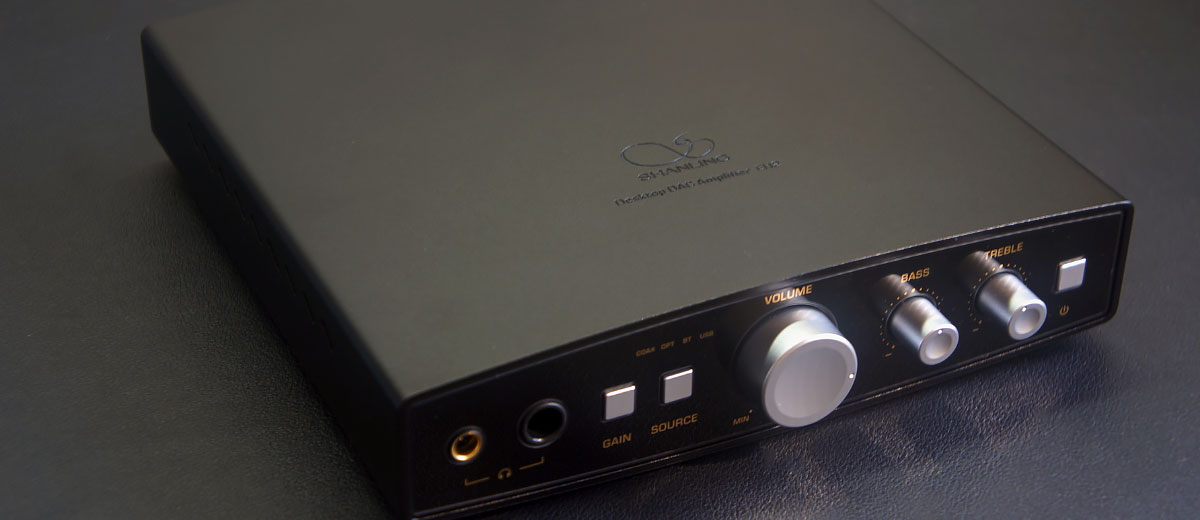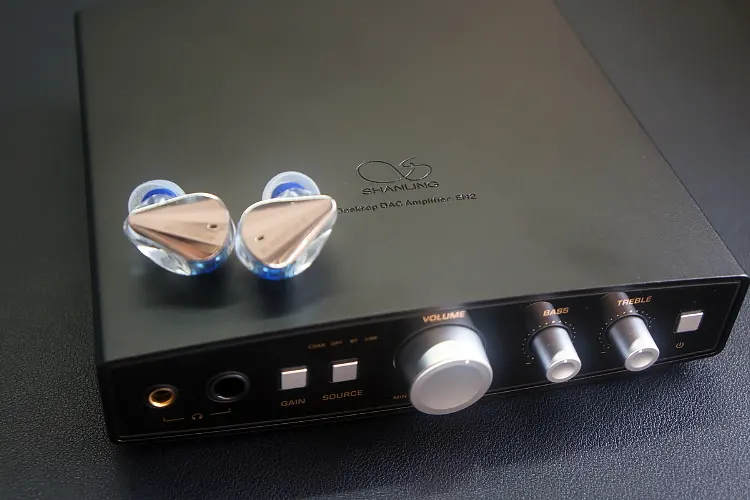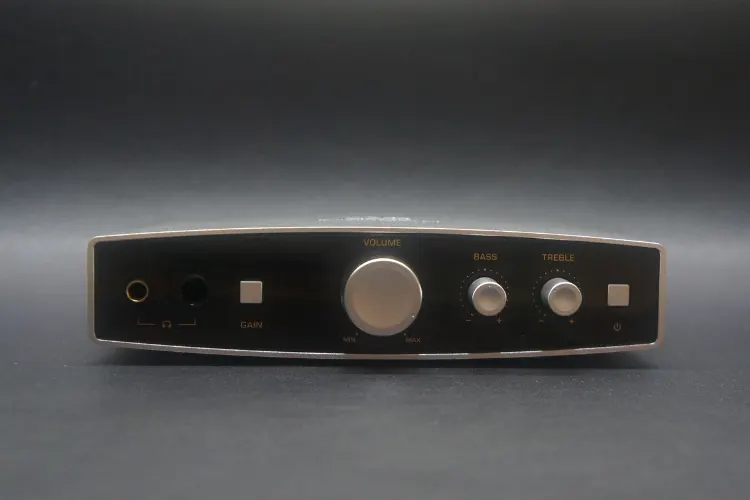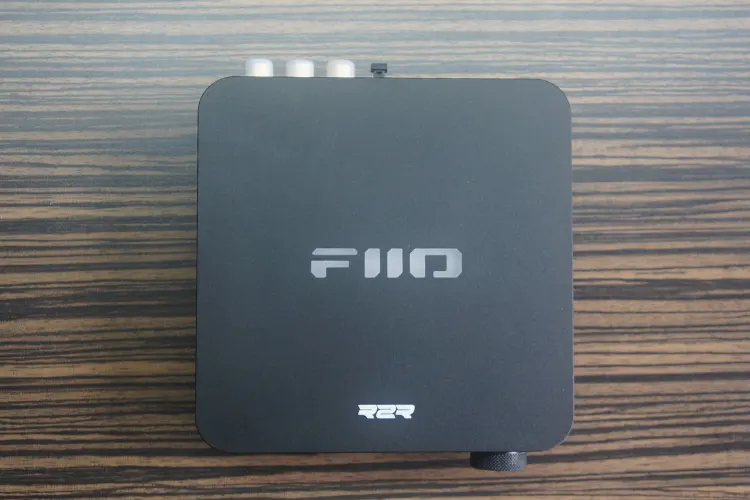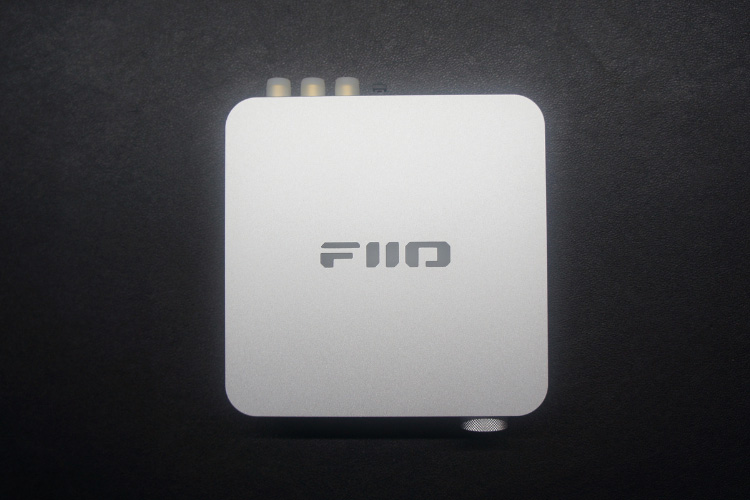Synergy
Power & Efficiency
The Shanling EH2 is a compact yet powerful DAC/Amp that delivers impressive performance for its size.
When connected to its dedicated 12V power adapter, the EH2 provides up to 4.3W at 32Ω through its 4.4mm balanced output and 1.3W at 32Ω via the 6.35mm single-ended output. This robust power output ensures that even demanding full-size headphones are driven effectively.
When paired with the Shanling EH2’s balanced output, it effortlessly drove the Sennheiser HD 580 Precision to satisfying levels at high gain with the volume knob at a 10-clock position.
On its SE output, the EH2 was able to drive my Audio-Technica R70X to a comfortable listening level while the volume knob was at a 2 o clock position.
On low gain, the Shanling EH2 also excelled with in-ear monitors such as the Moondrop Blessing 3. With its low signal-to-noise ratio, the EH2 was able to adequately drive more sensitive IEMs without noise or interference.
Pairings
The Shanling EH2 shines when paired with headphones and IEMs that benefit from a warmer sound signature while also taking advantage of its high-power output.
During my testing, the EH2 complemented the Audio-Technica R70X well, enriching its natural and organic presentation with added depth and fullness.
This pairing felt intuitive, as I’ve always found the R70X to perform best with warmer sources like my hybrid tube amplifier or the FiiO K11 R2R.
The EH2’s subtle warmth added a welcome sense of weight to the R70X’s sound without compromising its excellent soundstage and imaging.
Similarly, the Moondrop Blessing 3 paired well with the EH2. The EH2’s slight warmth subtly enhanced bass-heavy tracks, adding a touch of richness without sacrificing the midrange clarity and treble detail that make the Blessing 3 so enjoyable.
With its hefty 4.3W balanced power output, I found that the EH2 drives the notoriously demanding Modhouse Argon MK3 to listenable levels with very good dynamics and impact.
While I prefer pairing the Argons with more neutral sources, I found that turning down the unit’s bass control knob a few clicks maintained the headphone’s default tuning.
Select Comparisons
All comparisons were performed with the EH2 on OS mode and the tone control knobs on their neutral setting unless otherwise stated.
Shanling EH1
Technical
The Shanling EH2 builds upon the foundation set by the EH1. While the EH1 utilizes a Cirrus Logic CS43198 DAC, the EH2 adopts a custom 24-bit R2R DAC, offering a smoother and more analog-like presentation.
The EH2 significantly outperforms its predecessor power output, delivering up to 4.3W @32Ω through its balanced output, compared to the EH1’s 1.015W @32Ω.
Both models retain the versatile connectivity suite, including USB, coaxial, and optical inputs, but the EH2 enhances usability with Bluetooth 5.2 for wireless audio streaming.
Additionally, the EH2 maintains the EH1’s signature bass and treble tuning knobs, allowing users to adjust the tonal balance in real-time.
With these upgrades, the EH2 offers a more powerful and flexible solution, making it a compelling successor for those seeking improved performance and expanded functionality.
Design
The Shanling EH1 and EH2 are crafted from anodized aluminum, providing a sleek and durable finish.
The EH1 features a compact design with gentle curves, housing a straightforward interface that includes a large volume knob, bass and treble adjustment knobs, and dedicated buttons for power and gain control.
In contrast, the EH2 maintains a similar aesthetic but with a slightly larger footprint to accommodate enhanced internal components. It retains the curved aluminum chassis and front-facing controls, including the volume knob and tone adjustment knobs.
When compared side by side, the EH2 is larger and heavier than the EH1, reflecting its upgraded capabilities. Both units boast understated designs that can seamlessly integrate into any listening setup.
Performance
The Shanling EH1 and EH2 share a similar design philosophy but differ in sound performance due to their internal architecture differences.
The EH1 has a neutral-warm tuning with a smooth, relaxed presentation, offering tight bass with a slight mid-bass emphasis and a warm midrange that enhances male vocals and synths.
However, its warmth can slightly compress delicate instruments. In contrast, the EH2, featuring an R2R DAC, delivers a more natural and dynamic sound with deeper, more textured bass, clearer midrange separation, and a refined treble response with improved detail and airiness.
The EH2 also offers a more expansive soundstage and better imaging, while also delivering much higher power output, opening up its compatibility with a wider range of headphones.
FiiO K11 R2R
Technical
The FiiO K11 R2R and the Shanling EH2 utilize 24-bit R2R DAC architectures, delivering a natural and musical sound signature.
However, the EH2 offers significantly higher output power, rated at 1.3W and 4.3W @32Ω for its 6.35mm single-ended and 4.4mm balanced outputs, respectively, compared to the K11 R2R’s more modest output of 460mW and 1300mW @32Ω on 3.5mm SE and balanced 4.4mm.
Both devices feature USB, coaxial, and optical inputs, as well as balanced and single-ended headphone outputs, but the EH2 extends its versatility with Bluetooth 5.2 connectivity.
A standout feature of the EH2 is its dedicated bass and treble tuning knobs, allowing users to adjust the sound signature without external equalizers—an option absent in the K11 R2R.
Design
The FiiO K11 R2R and Shanling EH2 feature anodized aluminum construction, giving them a premium and durable finish. The EH2 sports a sleek, curved design with multiple knobs and buttons prominently placed on the front panel, emphasizing hands-on control.
In contrast, the K11 R2R has a more traditional boxy shape with rounded edges, resembling compact mini-PCs. When placed side by side, the EH2 is noticeably larger and heavier in every dimension.
Both devices maintain a subtle, modern aesthetic that blends well into any audiophile setup. However, the K11 R2R’s integrated screen and streamlined design, with fewer dedicated buttons and knobs, contribute to a more minimalist and refined look.
Performance
Both the Shanling EH1 and the K11 R2R share a warm-leaning sound signature characterized by rich, full bass lines and robust male vocals. However, the EH2 outclasses the K11 R2R in its mid-bass texture, dynamics, and resolution in the mid-bass.
The K11 R2R tends to overpower some mid-bass detail, while the EH2 is still able to deliver deep impactful bass while preserving good resolution.
Cymbal strikes and chimes on the EH2 carry a bit more shimmer, adding a touch of clarity and refinement to the treble. While neither unit leans heavily into treble emphasis, the EH1 retains a slight edge in detail retrieval and tonal accuracy in the upper frequencies.
In the midrange, both units share a warm tonal character that enriches lower-pitched vocals and synth tones. However, the EH2 stands out with its improved precision and texture, giving vocals more presence and energy, which adds an extra sense of depth to the overall mix.
FiiO K11
Technical
The FiiO K11 and Shanling EH2 take a different approach to desktop DAC/Amp design. The K11 features a Cirrus Logic CS43198 DAC, while the EH2 employs a custom 24-bit R2R DAC for a more analog-like sound signature.
The EH2 delivers a more robust output, reaching up to 4.3W @32Ω through its balanced output, compared to the K11’s 1.4W @32Ω. Both units offer versatile connectivity, including USB, coaxial, and optical inputs, but the EH2 adds Bluetooth 5.2 for wireless streaming
A key distinction is the EH2’s dedicated bass and treble tuning knobs, allowing real-time tonal adjustments. While the K11 remains a strong option with its streamlined interface and clean output, the EH2 offers greater power and customization for those looking to fine-tune their listening experience.
Design
Both the FiiO K11 and the Shanling EH2 are constructed from anodized aluminum, providing a sleek and durable finish. The EH2 features a sleek curved design with multiple knobs and buttons front and center.
In contrast, the K11 has a square shell with rounded edges, reminiscent of certain minicomputers. When compared side by side, the EH2 is larger in every physical dimension while also being heavier.
Both units boast understated designs that can seamlessly integrate into any audiophile setup. However, the K11’s screen and lack of dedicated buttons and control knobs give it a cleaner minimalist aesthetic.
Performance
The Shanling EH2 delivers a more pronounced sub-bass presence than the original FiiO K11, though its warmth is most apparent in the mid-bass region. This added richness lends bass guitars and synths a fuller, more immersive character.
In funk tracks, for instance, bass guitar lines carry greater texture and depth, making them more engaging and dynamic with the EH2’s tonal coloration.
However, the midrange performance of the Shanling EH1 falls short compared to the original K11. String instruments on the original K11 showcase better dynamics, detail, and texture, while the EH1’s midrange can come across as thinner and more one-dimensional, with the warmth sometimes masking the clarity of instruments.
Despite more emphasis in the lower mid-region, the EH2 can deliver similar levels of detail and texture, while improving dynamics as well.
Fans of more neutral and analytical sources may still prefer the K11 since it places a stronger emphasis on more delicate string instruments like acoustic guitars, but I found EH2 balanced a relaxing sound signature with good mid-range resolution.
The K11 delivers cymbals and chimes with greater air and detail, maintaining separation even in complex mixes. In contrast, the EH2 has slightly less proficient treble resolution performance.
However, by turning down the bass levels and increasing the volume, I found that I was able to tune the EH2 to sound much closer to the original K11. This opened up the treble quite a bit, but I still enjoyed the stock warm signature of the EH2.
My Verdict
Coming in at $369, the compact desktop Shanling EH2 expertly balances the satisfying organic warmth of an R2R DAC architecture with good resolution and dynamics, while also delivering an impressive 4.35W of balanced output power capable of driving a wide range of headphones.
The bass and treble knobs were tastefully implemented and acted as a convenient way to tune my listening experience on a track-per-track basis.
Its comprehensive suite of input options also meant I was able to pair it with my phone, laptop, consoles, and CD players with little to no fuss.
Those looking for a versatile all-in-one DAC/Amp with tuning flexibility, good power output, and natural-sounding default tuning should consider giving the EH2 a listen.
Shanling EH2 Specifications
- DAC/Amp Chip: 24-bit R2R DAC / BD139 & BD140 transistors
- Output Power: 4.3W @ 32Ω (BAL), 1.3W @ 32Ω (SE)
- Input(s): USB-C, Coaxial, Optical, Bluetooth 5.2
- Output: 6.35mm SE, 4.4mm BAL, RCA, 4.4mm Line Out
- Playback USB: 32-bit/768kHz, DSD512

